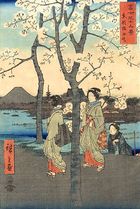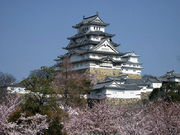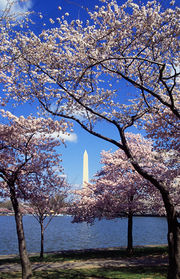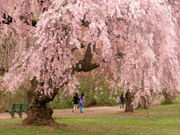Cherry blossom

と芝桜(しばざくら).jpg)
A cherry blossom is the name for the flower of cherry trees known as Sakura (Japanese kanji : 桜 or 櫻; hiragana: さくら) in Japanese. In English, the word "sakura" is equivalent to the Japanese flowering cherry.[1][2] Cherry fruit (known in Japanese as sakuranbo) comes from another species of tree.
Contents |
Natural history
Cherry Blossoms are indigenous to many East Asian states including Japan, Korea, China. Japan has a wide variety of cherry blossoms (sakura); well over 200 cultivars can be found there.[3]
Flower viewing
The practice of hanami is many centuries old. The custom is said to have started during the Nara Period (710–794) when it was ume blossoms that people admired in the beginning. But by the Heian Period (794–1185), sakura came to attract more attention and hanami was synonymous with sakura.[4] From then on, in tanka and haiku, "flowers" meant "sakura." The custom was originally limited to the elite of the Imperial Court, but soon spread to samurai society and, by the Edo period, to the common people as well. Tokugawa Yoshimune planted areas of cherry blossom trees to encourage this. Under the sakura trees, people had lunch and drank sake in cheerful feasts.

Every year the Japanese Meteorological Agency and the public track the sakura zensen (cherry-blossom front) as it moves northward up the archipelago with the approach of warmer weather via nightly forecasts following the weather segment of news programs. The blossoming begins in Okinawa in January and typically reaches Kyoto and Tokyo at the end of March or the beginning of April. It proceeds into areas at the higher altitudes and northward, arriving in Hokkaidō a few weeks later. Japanese pay close attention to these forecasts and turn out in large numbers at parks, shrines, and temples with family and friends to hold flower-viewing parties. Hanami festivals celebrate the beauty of the cherry blossom and for many are a chance to relax and enjoy the beautiful view. The custom of hanami dates back many centuries in Japan: the eighth-century chronicle Nihon Shoki (日本書紀) records hanami festivals being held as early as the third century CE.
Most Japanese schools and public buildings have cherry blossom trees outside of them. Since the fiscal and school year both begin in April, in many parts of Honshū, the first day of work or school coincides with the cherry blossom season.
Symbolism
In Japan cherry blossoms also symbolize clouds due to their nature of blooming en masse, besides being an enduring metaphor for the ephemeral nature of life,[5] an aspect of Japanese cultural tradition that is often associated with Buddhistic influence,[6] and which is embodied in the concept of mono no aware.[7] The association of the cherry blossom with mono no aware dates back to 18th-century scholar Motoori Norinaga.[7] The transience of the blossoms, the extreme beauty and quick death, has often been associated with mortality;[5] for this reason, cherry blossoms are richly symbolic, and have been utilized often in Japanese art, manga, anime, and film, as well as at musical performances for ambient effect. The band Kagrra, which is associated with the visual kei movement, is an example of this latter phenomenon. There is at least one popular folk song, originally meant for the shakuhachi (bamboo flute), titled "Sakura", and several pop songs. The flower is also represented on all manner of consumer goods in Japan, including kimono, stationery, and dishware.
Cherry blossom is an omen of good fortune and is also an emblem of love, affection and represents spring. Cherry blossoms are an enduring metaphor for the fleeting nature of life, and as such are frequently depicted in art.

During World War II, the cherry blossom was used to motivate the Japanese people, to stoke nationalism and militarism among the populace.[8][9] Japanese pilots would paint them on the sides of their planes before embarking on a suicide mission, or even take branches of the trees with them on their missions.[8] A cherry blossom painted on the side of the bomber symbolized the intensity and ephemerality of life;[10] in this way, the aesthetic association was altered such that falling cherry petals came to represent the sacrifice of youth in suicide missions to honor the emperor.[8] The government even encouraged the people to believe that the souls of downed warriors were reincarnated in the blossoms.[8]
In its colonial enterprises, imperial Japan often planted cherry trees as a means of "claiming occupied territory as Japanese space".[9]
Varieties and blooming
- Prunus serrulata
- Prunus speciosa
- Prunus × yedoensis
- Prunus sargentii
The most popular variety of sakura in Japan is the Somei Yoshino. Its flowers are nearly pure white, tinged with the palest pink, especially near the stem. They bloom and usually fall within a week, before the leaves come out. Therefore, the trees look nearly white from top to bottom. The variety takes its name from the village of Somei (now part of Toshima in Tokyo). It was developed in the mid- to late-19th century at the end of the Edo period and the beginning of the Meiji period. The Somei Yoshino is so widely associated with cherry blossoms that jidaigeki and other works of fiction often depict the variety in the Edo period or earlier; such depictions are anachronisms.
Winter sakura (fuyuzakura/Prunus subhirtella autumnalis) begins to bloom in the fall and continues blooming sporadically throughout the winter. It is said to be a cross between Tokyo Higan cherry (edohiganzakura/P. incisa) and Mamezakura/P. pendula.[11]
Other categories include yamazakura, yaezakura, and shidarezakura. The yaezakura have large flowers, thick with rich pink petals. The shidarezakura, or weeping cherry, has branches that fall like those of a weeping willow, bearing cascades of pink flowers.
Cherry blossoms in other countries
Canada
Vancouver, BC is famous for its thousands of cherry blossom trees lining many streets and in many parks, including Queen Elizabeth Park and Stanley Park. Vancouver holds the annual Vancouver Cherry Blossom Festival every year.[12] High Park in Toronto, ON features many Somei-Yoshino cherry trees (the earliest species to bloom and much loved by the Japanese for their fluffy white flowers) that were given to Toronto by Japan in 1959. Through the Sakura Project, the Japanese Embassy donated a further 34 cherry trees to High Park in 2001, plus cherry trees to various other locations like Exhibition Place, McMaster University, York University and the University of Toronto's main and Scarborough campuses.
Germany
The cherry blossom is a major tourist attraction in Germany's Altes Land orchard region.
Philippines
A province in Western Philippines, Palawan, serves as home to an endemic Palawan Cherry Blossoms, which appears to resemble that of Japan's, thus the name.
South Korea
Watching of cherry blossom was introduced to Korea during Japanese rule.[13][14] The festivals continued even after the Japanese surrendered in WWII. "In 1933, the Japanese botanist Koizumi Genichi reported that the Japanese Sakura (Somei Yoshino) is of Jeju-do island origin.[15] In 1992, Takaki Kiyoko, another botanist specializing in sakura, also claimed that the Yoshino sakura hails from Jeju Island. According to Invest Korea journal, more evidence supporting this claim is that while this species of cherry tree is indigenous to Korea and can be found as part of the natural flora of Mount Halla, it cannot be found anywhere in Japan".[16] However, this claim did not become the mainstream of botanists. In 1916, Ernest Henry Wilson insisted on "Japanese Sakura (Somei Yoshino)" was a crossbreed of the wild species of Japanese Sakura ("Edo higan" and "Oshima sakura").[17] In 1991, Professor of Tsukuba University Iwasaki Fumio reported that "Japanese Sakura (Somei Yoshino) were born in around 1720-1735 by the artificial crossing in Edo (Tokyo)."[18] Recent studies conducted on the comparison of Korean and Japanese cherry blossoms by botanist concluded that the two trees can be categorized as distinct species when analyzed by inter-simple sequence repeat and chloroplast DNA in 2007.[19] Further studies are ongoing. This lead Japan to develop many theories on how and where the cultivated hybrids came to be but its origin is still obscure.[20] Scientia Horiculturae volume 114 states cherry blossoms "that grows under natural environments in Jeju, Korea and of Yoshino cherry hybrids that grows only in cultivated conditions in Japan".[19][21] Certain trees at Seoul's Gyeongbok Palace were cut down to celebrate the fiftieth anniversary of Japanese surrender in World War II.[9] Although Cherry blossoms are already indigenous to Korea, Japan had planted these tree on sacred and offensive locations in the Palace. Once the offensive trees were cut down the festival continued with the indigenous trees. The cherry blossom festival at Gyeongbok Palace is one of a number of such festivals across Korea and is prominently advertised to tourists.[22]
Turkey
5 years ago Japanese cherry trees were presented by Japan to the Nezahat Gokyigit Botanical Garden in Istanbul, Turkey. Each tree represents one sailor of Ertugrul Frigate which was the a famous frigate of the Ottoman/Turkish navy. She had encountered a typhoon on the way back from a goodwill visit to Japan in 1890. That heavy weather condition caused her to sink. That disaster resulted with unfortunate loss of 587 Ottoman/Turkish sailors. That unfortunate occurrence is being remembered in every anniversary. The Japanese Cherry Trees represent memory of those passed away and provide remembarance.
United Kingdom
Batsford Arboretum in Gloucestershire holds the national collection of Japanese village cherries, sato-sakura group.[23][24]
United States

Japan gave 3,020 cherry blossom trees as a gift to the United States in 1912 to celebrate the nations' then-growing friendship, replacing an earlier gift of 2000 trees which had to be destroyed due to disease in 1910. These trees were planted in Sakura Park in Manhattan and famously line the shore of the Tidal Basin in Washington, D.C. (see West Potomac Park). The gift was renewed with another 3,800 trees in 1965.[25] [26] The cherry blossom trees continue to be a popular tourist attraction (and the subject of the annual National Cherry Blossom Festival) when they reach full bloom in early spring. Also, Balboa Park of San Diego has 2,000 cherry blossom trees that blossom in mid to late March. In Los Angeles, over 2,000 trees are located at Lake Balboa in Van Nuys. These trees were donated by an anonymous Japanese benefactor and were planted in 1992. They originated from a single parent tree and were developed to grow in warm climates.[27] Philadelphia is also home to over 2000 flowering Japanese cherry trees, half of which were a gift from the Japanese government in 1926 in honor of the 150th anniversary of American independence, with the other half planted by the Japan America Society of Greater Philadelphia between 1998 and 2007. Philadelphia's cherry blossoms are located within Fairmount Park, and the annual Subaru Cherry Blossom Festival of Greater Philadelphia celebrates the blooming trees. The University of Washington in Seattle also has cherry blossoms in its Quad.

Other US cities have an annual Cherry Blossom Festival (or Sakura Matsuri), including the International Cherry Blossom Festival in Macon, Georgia, which features over 300,000 cherry trees. Belleville, Bloomfield, and Newark, New Jersey celebrate the annual Branch Brook Park Cherry Blossom Festival in April, which attracts thousands of visitors from the local area, Japan, and India. As of April 2009, Branch Brook Park has a cherry tree collection with over 4,000 cherry blossoms in more than fourteen different varieties.[28] Branch Brook Park will soon have more flowering cherry trees than Washington, D.C., thanks to an ongoing replanting program. The Brooklyn Botanic Garden in New York City also has a large, well-attended festival.
Culinary use


Cherry blossoms and leaves are edible and both are used as food ingredients in Japan. The blossoms are pickled in salt and umezu and used for coaxing out flavor in wagashi or anpan. Salt-pickled blossoms in hot water is called sakurayu and drunk at festive events like weddings in place of green tea. Leaves, mostly Ōshima cherry because of the softness, are also pickled in salted water and used for sakuramochi. Since the leaves contain coumarin, however, it is not recommend to eat them in great quantity.
See also
- Prunus
- Kigo: discussion of the role of sakura in Japanese poetry
- Mono no aware
- Kabazaiku: sakura wood craftsmanship
- Subaru Cherry Blossom Festival of Greater Philadelphia
- Cherry
- The Cherry Orchard
- Ohka: Special Attack Aircraft of World War II
Notes
- ↑ "sakura". Webster's Third New International Dictionary, Unabridged. Merriam-Webster. 2002. http://unabridged.merriam-webster.com/cgi-bin/unabridged?va=sakura. Retrieved 2008-04-02. "JAPANESE FLOWERING CHERRY".
- ↑ "japanese flowering cherry". Webster's Third New International Dictionary, Unabridged. Merriam-Webster. 2002. http://unabridged.merriam-webster.com/cgi-bin/unabridged?book=Third&va=japanese+flowering+cherry. Retrieved 2008-04-02. "any of certain ornamental hybrid cherries developed in Japan chiefly from two species (Prunus serrulata and P. sieboldii) that bear a profusion of white or pink usually double and often fragrant flowers followed by small inedible fruit...".
- ↑ Brandow Samuels, Gayle.
- ↑ Brooklyn Botanic Garden (2006). Mizue Sawano: The Art of the Cherry Tree. Brooklyn Botanic Garden. p. 12. ISBN 1889538256. http://books.google.com/books?id=nHf8lxLOYsUC&pg=PA12&dq=Hanami+nara#v=onepage&q=Hanami%20nara&f=false.
- ↑ 5.0 5.1 Choy Lee, Khoon. Japan--between Myth and Reality. 1995, page 142.
- ↑ Young, John and Nakajima-Okano, Kimiko. Learn Japanese: New College Text. 1985, page 268.
- ↑ 7.0 7.1 Slaymaker, Douglas. The Body in Postwar Japanese Fiction. 2004, page 122.
- ↑ 8.0 8.1 8.2 8.3 Ohnuki-Tierney, Emiko. Kamikaze, Cherry Blossoms, and Nationalisms. 2002, page 9-10.
- ↑ 9.0 9.1 9.2 Ohnuki-Tierney, Emiko. Kamikaze, Cherry Blossoms, and Nationalisms. 2002, page 122-3.
- ↑ Sakamoto, Kerri: One Hundred Million Hearts. Vintage Book, 2004. ISBN 0-676-97512-7.
- ↑ "Winter-flowering cherry". Retrieved 1 January, 2008.
- ↑ "Vancouver Cherry Blossom Festival - VCBF.CA". vcbf.ca. http://www.vcbf.ca/. Retrieved 26 April 2010.
- ↑ "몰락한 왕조 궁궐에 핀 사쿠라 일제는 갔어도 벚꽃놀이는 남아". 中央日報. http://article.joins.com/article/article.asp?total_id=3576782. Retrieved 2009-05-11.
- ↑ "胸と肩に桜の花を挿して犠牲を誓う18歳の操縦士". 中央日報. http://japanese.joins.com/article/article.php?aid=113981&servcode=100§code=140. Retrieved 2009-05-11.(Japanese)
- ↑ Koidzumi, G. Prunus yedoensis Matsum. is a native of Quelpaert. Acta Phytotaxonomica et Geobotanica, 1:177, 1932
- ↑ "IK-Journal". Investkorea.org. 1952-04-13. http://www.investkorea.org/InvestKoreaWar/work/journal/content/content_main.jsp?code=4560408. Retrieved 2009-11-30.
- ↑ The Cherries of Japan (page 16) (1916).
- ↑ ソメイヨシノとその近縁種の野生状態とソメイヨシノの発生地. 筑波大農林研報 (1991), 3:95-110.
- ↑ 19.0 19.1 "Characterization of Wild Prunus Yedoensis Analyzed by Inter-Simple Sequence Repeat and Chloroplast DNA". United StatesDepartment of Agriculture. http://www.ars.usda.gov/research/publications/publications.htm?SEQ_NO_115=205306. Retrieved 2009-05-14.
- ↑ "THE ORIGIN OF THE YOSHINO CHERRY TREE - TAKENAKA 54 (5): 207 - Journal of Heredity". Jhered.oxfordjournals.org. http://jhered.oxfordjournals.org/cgi/pdf_extract/54/5/207. Retrieved 2009-11-30.
- ↑ "Scientia Horticulturae : Characterization of wild Prunus yedoensis analyzed by inter-simple sequence repeat and chloroplast DNA". ScienceDirect. http://www.sciencedirect.com/science?_ob=ArticleURL&_udi=B6TC3-4P7FHTX-1&_user=10&_rdoc=1&_fmt=&_orig=search&_sort=d&view=c&_acct=C000050221&_version=1&_urlVersion=0&_userid=10&md5=b18ded64a95960f2d7ceb5dd2e340f77. Retrieved 2009-11-30.
- ↑ "Korean Festivals in Seoul| Official Seoul City Tourism". English.visitseoul.net. http://english.visitseoul.net/visit2007en/events/calendarofevents/calendarofevents.jsp?cid=127&sid=1985. Retrieved 2009-11-30.
- ↑ "Batsford Arboretum". Batsarb.co.uk. http://www.batsarb.co.uk. Retrieved 2009-11-30.
- ↑ "Batsford Arboretum". NCCPG. http://www.nccpg.com/page57.aspx?Code=501. Retrieved 2009-11-30.
- ↑ "nps.gov - Cherry Blossom History". http://www.nps.gov/cherry/cherry-blossom-history.htm. Retrieved 13 January 2009.
- ↑ Jefferson, Roland M. and Alan F. Fusonie. (1977). "The Japanese Flowering Cherry Trees of Washington, D.C.: A Living Symbol of Friendship. National Arboretum Contribution No. 4." Washington: USDA, Agricultural Research Service.
- ↑ The Big Bloom of Cherry Blossoms at Lake Balboa in Van Nuys [1]
- ↑ http://www.essex-countynj.org/blossom/flier09.pdf
External links
- Vancouver Cherry Blossom Festival, Information about the 37,000 cherry trees in Greater Vancouver (Canada), What's in bloom now, Cherry Scout reports and maps, Cultivar identification.
- Subaru Cherry Blossom Festival of Greater Philadelphia, Information about cherry trees and the annual two-week Subaru Cherry Blossom Festival of Greater Philadelphia.
- Cherry Blossom Spots in Japan
- Sakura in Kyoto
- Cherry Blossom Photos
- Cherry Blossoms at Branch Brook Park
- Branch Brook Park cherry blossoms, April 2008
- Copenhagen Sakura Festival
- the place you can see Sakura blossom in Taipei Taiwan (Chinese version)
- Pictures of sakura in Japan